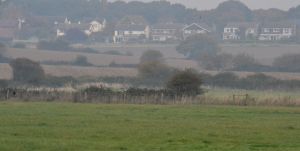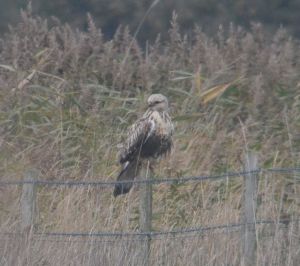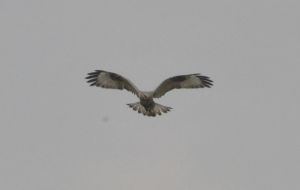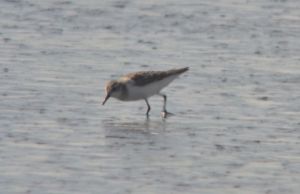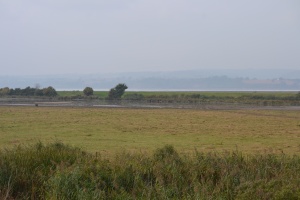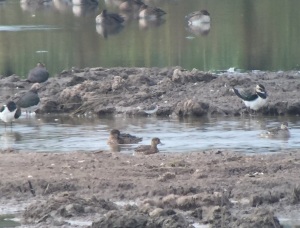Being free of work commitments this week I was pleased to accept an invite from Ewan and Clackers to go with them to see one of this autumn’s crop of Rough-legged Buzzard. Our bird was at Holland Haven Country Park just east of Clacton-on-Sea in Essex. So at just after 6am I was collected at home by the fabled black Audi and off we sped.
On arrival around three hours later we headed for a bird hide that is actually two shipping containers stacked on top of one another, to scan an area of coastal grazing marsh beyond which is a golf course. The Clackmeister quickly located the Rough-leg, an attractively pale and creamy-toned juvenile perched on a fence post between those two areas. Ewan at once rushed off to get closer but I lingered to scope the bird adequately at that range. It was already clear that we were in for much more satisfying views of this species than my last encounter at Braughing, Herts in November 2014.
Eventually Clackers and I walked to join Ewan and several other birders and photographers who were watching this raptor and hoping it would fly across the marsh towards them. We learned that it moves around this site a lot offering close views at times. For the next couple of hours the Rough-legged Buzzard tantalised its audience by moving right a few or several posts at a time along a fence to the rear of the grazing marsh, always watching the ground before it intently and turning its head on a 180 degree axis like an owl. At one point it swooped onto and caught a large looking vole, then eventually it flew all the way left again to start anew. My digiscoped images (below) show how this bird was seen at that range.
- Rough-legged Buzzard
At this point I left the group to walk a little closer, then the RLB seemingly tired of its ground searching and took to the air, flying towards the sea. I saw all the other birders follow at once then it hovered, as RLBs do right above two photographers who were stationed on the sea wall. “Some jammy sods have all the luck,” I thought, but when I got over there the RLB flew towards me and hovered again quite close. I had not witnessed this diagnostic behaviour before and the day’s experience was improving all the time. An excited jogger asked if the bird was a Buzzard or a Kestrel and was clearly impressed.
Ewan and I then walked back towards the container hide to which Clackers had already gone, locating the RLB again at closer range. First one then two Short-eared Owl suddenly appeared at this point quartering the marsh. Earlier a fly through ring-tailed Hen Harrier had enhanced the morning’s entertainment, and I also gained an unusually close view of a Woodcock upon first walking away from the hide. Purple Sandpiper were being reported on the beach but when we went to look the tide was in.
To quote the Helm Guide To Bird Identification, a typical view of RLB is of a large, pale buzzard hovering over coastal fields and marshes, with ponderous wing beats or hanging motionless, the tail twisted and turned like a Kite’s. The species is slightly larger, longer-winged and sturdier than a Common Buzzard; pale headed with a clear cut black and white tail and black belly patches. All these diagnostics were plain to see today and like the Lincs Red-footed Falcon that I observed at length in August, this Rough-legged Buzzard offered excellent value.

